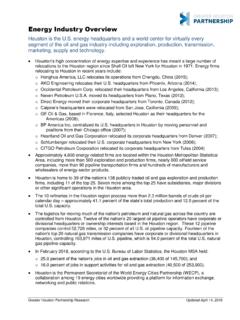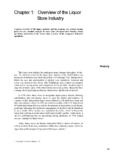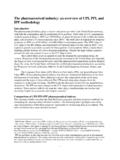Transcription of Overview of the Indian Auto Component industry
1 Overview of the Indian Automotive Component industry As the Indian auto components industry treads a difficult path through an uncertain near term future - operational excellence, scenario planning and risk management are poised to become the key arsenal for success says Atish Mukhopadhyaya (Principal Delivery Excellence and Automotive &. Engineered Products) of Tata Strategic Management Group. Introduction The global economic uncertainties and domestic monetary tightening measures have built up a near term negative sentiment for the Indian auto Component industry . However the long term prospects of the industry are definitely perceived as a huge opportunity area. The cyclical nature of the automotive industry over several decades has helped hone the survival skills of the industry .
2 But this survival instinct is being put to test because new strategies and skill sets are required to mitigate the current challenges. Overview of the Auto Component industry The Indian auto industry is highly competitive with a number of global and Indian auto-companies present. The size of auto Component industry in India is around USD billion and has grown at ~26% since FY 05. (Figure 1). Though the industry witnessed slower growth in 2008 09 owing to the global slowdown, Indian auto Component manufacturers are equipped to address the challenges of a downturn. Figure 1: Auto Component industry production, (USD billion). 23. 18 15. ` 12 For exports For domestic consumption FY05 FY06 FY07 FY08 FY09 FY10 FY11.
3 Source: Auto Component Manufacturers Association (ACMA). Over the years Indian auto Component companies have increased their footprint in global markets and the exports have grown at ~17% in the last six years to reach USD billion in FY11 (Figure 1). Significant number of auto Component manufacturers are focusing on global best practices like 5-S, Kaizen, TQM, TPM, 6. Sigma etc. and in the process more companies are getting recognized with quality certifications. The Indian auto industry has evolved around three major clusters: Mumbai-Pune-Nashik-Aurangabad (West);. Chennai-Bangalore-Hosur (South); and Delhi-Gurgaon-Faridabad (North). 1 Tata Strategic Management Group Figure 2: Auto Component export destinations FY11, (% of total).
4 Others, 11%. Europe, North 37%. America, 24%. Asia, 28%. Source: ACMA. Low labour costs, availability of skilled labour and high quality consciousness among Indian vendors have spurred the growth of auto Component exports from India. Moreover, over the last few years, the structure of the customer base in the global markets has also undergone a major change. In the 1990s most of the exports were made to the international aftermarket whereas at present most of the exports are made to the global OEMs and Tier 1 companies. From FY05 to FY09 the exports grew at a rate of 22% to reach USD billion. However, in FY10 exports remained flat at USD billion and contributed ~17% to overall production.
5 YoY growth for FY 11 was ~16% and grew to a value of USD billion in FY11 (Figure 1). Europe accounted for over 37% of exports followed by Asia and North America at 28% and 24% respectively (Figure 2). The domestic consumption on the other hand has grown at ~26% over the last 6 years to reach USD 36. billion in FY 11 (Figure 3). Still Indian auto Component industry has a small, ~1% share of the global Auto Components industry . Figure 3: Auto Component consumption, (USD billion). 12. From imports From domestic players FY05 FY06 FY 07 FY 08 FY09 FY10 FY11. Source: ACMA. While the domestic market saw a growth of YoY, imports of auto components fell by more than 35% in FY11 to USD billion (Figure 3), but Asian countries continue to be largest source of imports at 54% (Figure 4).
6 The auto components industry production can be divided on the basis of its usage patterns across user segments. The broad classification would be auto components produced for OEM, exports and after-markets. Further, within the OEM demand, there is segregation based on vehicle segment types. 2 Tata Strategic Management Group Figure 4: Auto Component imports - source locations FY11 (% of total). North Others, 2%. America, 8%. Europe, 36% Asia, 54%. Source: ACMA. The production for OEM's is estimated at about 72%, followed by production for after-market at 17% and production for exports at 11%. Of the OEM demand, around 53 per cent is driven by cars and utility vehicles (Figure 5).
7 Figure 5: Auto Component industry End user segments (FY11). Exports OEM. 11% SEGMENTWISE. OFFTAKE. After- CVs &. market Tractors, 17% 27%. Cars & UV, 53%. 2&3. Wheeler OEM 20%. 72%. Source: CRISIL Research Segmentation of the auto Component industry The industry , over the years, has developed the capability of manufacturing all components required to manufacture vehicles, which is evident from the high levels of indigenization / localization achieved in the vehicle industry as well as the components developed for the completely Indian made vehicles like the Tata Indica, Tata Indigo, Mahindra Scorpio, Bajaj Pulsar etc. The Component industry has now holistic capability to manufacture the entire range of auto-components Engine parts, Drive, Transmission Parts, Suspension &.
8 Braking Parts, Electricals, Body and Chassis Parts, Equipment etc. Indian auto Component industry can be broadly segmented into six major segments. Engine and drive transmission parts together contribute about 50 per cent of the auto Component industry production. Engine parts, which constitute 31 per cent of the production, mainly comprise of pistons, engine valves, carburettors, fuel injection systems, camshafts, crankshafts and cooling systems. Drive transmission parts, which constitute 19 per cent of the total production, include axle assembly, steering parts and clutch assembly (Figure 6). The domestic auto components industry consists mostly of unorganized players, who are largely small and 3 Tata Strategic Management Group medium enterprises.
9 However, it is the organized segment that contributes about 72 per cent of the industry 's total revenues. About 619 organized players are registered with the Auto Component Manufacturers Association (ACMA). Figure 6 : Segment wise production (% of total), FY11. Othjers suspension 9%. & braking parts Engine parts 10% 31%. Body and c hassis 12%. equipment & transmission elec tric al & steering parts 19%. 19%. Source: Crisil Research Classification based on size of revenues (FY11). No. of companies Revenue range 231 < USD 1-5 mn 194 < USD 5-25 mn 90 < USD 25-50 mn 58 < USD 50-100 mn 46 > USD 100 mn Source: CRISIL Research The organized sector is dominated by large promoter groups.
10 Of this, while MNCs contribute 12 per cent of revenues; the domestic promoter groups contribute 35 per cent, while the balance comes from smaller companies (Figure 7). Prevalent business models are: Full Indian ownership Indian owner and MNCs in technical alliance Indian owner and MNC JV. Complete MNC subsidiary Figure 7: Structure of Indian Auto- Component sector 1 2%. 25%. 35 %. 28 %. MNC Indian Pro mo t e r Uno rganise d P rivat e (Ind ian). Source: ACMA. 4 Tata Strategic Management Group Investment Profile Investments in Indian auto Component sector have grown from around ~USD 4 billion in FY05 to ~USD billion in FY11 (Figure 8). Due to recession there was postponement of investment plans because of which the investment levels remained unchanged between FY08 and FY09.







